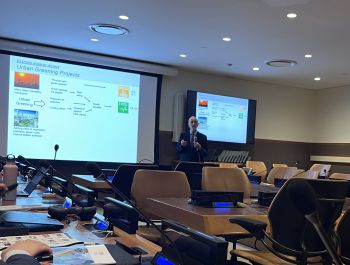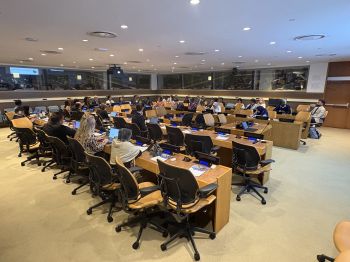News
SSRP launches timely 'Synergy Drivers’ report at the United Nations High-Level Political Forum
By: Sephora Imomoh
Last updated: Friday, 25 July 2025

Prof. Alcamo launching the SSRP's Synergy Drivers for Accelerating the SDGs report

Attendees at the UN HLPF side event
Countries can cope with declining resources for the SDGs by adopting efficient “synergy driver” policies that accomplish multiple targets at the same time. This was the key takeaway from the recent side event organised by the UK Mission to the UN and the Sussex Sustainability Research Programme. The event launched the Foreign and Commonwealth Development Office (FCDO) funded report – Synergy Drivers for Accelerating the SDGs produced by the SSRP.
Ms Tara Soomro, UK Ambassador to the Economic and Social Council, opened the event, stating that the idea of synergy drivers is timely, given the significant constraints faced by institutions and governments.
The keynote address was given by Prof Joseph Alcamo, the lead author of the report and professor in the department of Geography at the University of Sussex and Director of the University’s Centre of Excellence – the Sussex Sustainability Research Programme. He presented highlights of the report, beginning by noting that “the latest report from the Secretary General’s office estimates that 47% of SDG targets are lagging and a further 18%, including the goal to eliminate hunger, are actually going backwards”. He continued: “While we struggle to achieve the SDGs, at the same time resources for implementing them are in decline. To make the most out of existing resources the Sussex report recommends that countries consider adopting ‘Synergy Drivers’- i.e. policies and measures that advance multiple SDG targets at the same time.”
Professor Alcamo explained that the Sussex report is a “proof of concept” of the synergy driver idea, and presents ten examples of these policies, including ‘Decentralised Solar Energy Systems’, and ‘Clean Cookstove Programmes’”. Many of the examples are based on research at Sussex. He explained in detail how one of the ten examples, “Urban Greening Projects”, substantively achieves multiple SDG targets and how these assertions are backed up by strong scientific evidence. He said, “Working at the target level, synergy driver policies are likely to align with country-level SDG priorities.” He said further: “Synergy drivers have the potential to save country resources by avoiding the duplication of policies, allowing the pooling of resources, and maximising the return of investments in infrastructure.”
Ms Karima Elkorri, the Director, Sustainable Development unit, the Executive Office of the UN Secretary General, in her comments, stated that identifying synergies and scalable solutions is no longer a choice; we have to be intentional about making progress, given that two-thirds of the SDGs are off track, looking at global aggregates. Progress has been withheld by chronic underinvestment, fragmented and siloed approaches to addressing the SDGs, as well as many global shocks, climate events, shocks to the food system and other health issues. Pleased to see the wealth of scientific evidence backing the synergistic approach, Ms Elkorri stated that it is clear that the benefits of exploiting synergies far outweigh the trade-offs.
Country representatives from Ghana, Indonesia and Ethiopia also shared their approaches that can be linked to Synergy Drivers. Dr. Audrey Smock Amoah, Director General of the National Development Planning Commission, Ghana, shared several examples of initiatives the Government of Ghana has implemented including school feeding programmes linked to supporting local farmers, free senior school initiatives, and free sanitary pad distribution, these social protection programmes advance multiple SDGs including SDG 5 – Gender Equality, SDG 4 – Quality Education and SDG 1 – No poverty among others.
Dr Arifin Rudiyanto, the coordinator of the National SDG Secretariat in Indonesia, highlighted some examples from the country including Indonesia’s post-COVID recovery resilience initiative, addressing SDG 1, SDG 3, SDG 9, SDG 11, and SDG 10. The initiative expanded primary healthcare, expanded social assistance for vulnerable groups, increased food access, and reduced inequalities. Through the green finance and sustainable investment initiative, Indonesia also channelled capital and finance towards sustainable energy, SDG 7 sustainable agriculture, and green infrastructure, addressing multiple SDGs. The country’s flagship programme on low-carbon development promotes circular economy, coastal and marine ecosystems, and enhances resilience. The social forestry programmes advance SDG 1, SDG 3, SDG 8, and SDG 15. The blue economy road map through climate resilient marine infrastructure, fostering climate adaptation, and addressing multiple SDGs.
From Ethiopia, Mr Tegene Mengeste, a Development Planning and Policy Advisor for the Ethiopian Government, shared examples of several social protection initiatives addressing SDG 1 and SDG 4, including a school feeding programme. Ethiopia has also been successful in generating hydroelectric power, addressing SDG 7, and excess capacity is sold to its neighbouring countries. Ethiopia has successfully improved access to energy and the quality of life for rural communities, addressing SDG 1. The Ethiopian government’s response to disaster management involves building large-scale granaries for long-term crop storage, thereby supporting farmers and addressing SDG 8 and SDG 1.
Returning to the UN organisation, Mr. Babatunde Abidoye, the Global Policy Advisor for SDG integration at UNDP, highlighted the importance of the Synergy Driver approach, as it can justify investment at the Country level. He provided an example of a report produced by the UNDP in collaboration with 95 countries, the Insights Report on SDG Synergies and Interlinkages, which examines aggregated global-level data and analysis. Although useful, it was not always relevant to specific national contexts. He reflected that the Synergy Driver approach can be highly relevant at the country level. The UNDP found that investments in digital infrastructure, social protection, and the green economy could pull many people out of poverty. They have been exploring ways to collaborate with UN country teams to initiate national-level conversations, examining contexts, progress, and synergies to identify where investments already exist and managing progress in light of resource constraints.
The panel was closed out by Sephora Imomoh, SSRP Senior Programme Manager, one of the report's authors. She spoke about the importance of civil Society Organisations and businesses in driving the implementation of Synergy Drivers at the target level, citing the example of women-led businesses in the technology sector. Pele Green Energy, a company run by a Sussex alumnus (Fumani Mthembi) that delivers renewable energy projects and provides training and learning opportunities for people in the communities they serve, addressing SDG 4, SDG 5 and SDG 7. With over 600 million people in Sub-Saharan Africa lacking access to energy, Ms Imomoh stated that the social enterprise Solar Sister is also bringing clean energy products to last-mile communities, addressing SDG 5, SDG 7 and SDG 8.
The event was ably chaired by Grace Wood, the Head of the Sustainable Development Team at the UK Mission, who reaffirmed the need for multiple partners to drive positive action and stated that organisations such as UNDP that work across multiple geographic regions will be critical partners in ensuring accelerated action on the SDGs.
In her closing remarks, Ambassador Soomro thanked the University of Sussex and the Institute of Development Studies for the work done, citing Sussex's expertise in Development Studies. She also thanked the speakers for bringing examples of synergy drivers in action stating that the variety of examples of the synergistic approach is exactly what is needed to drive progress on the SDGs.
The SSRP is looking forward to working with key organisations, including UNDP, in driving forward action on the SDG synergy drivers.
The Synergy Drivers for Accelerating the SDGs report is available online on the evidence library of the UK International Development Fund and can be downloaded via the Sussex Sustainability Research Programme website.
On 18 July 2025, the UK Mission to the UN, and the SSRP co-organised a side event at the annual UN General Assembly meeting on sustainable development to launch the SSRP’s new report on how to accelerate the SDG’s. The report was commissioned and funded by the Foreign, Commonwealth and Development Office (FCDO), UK.
Further information: https://www.evidencefund.com/lib/XHNYMB2X/download/9L5DN5ZD